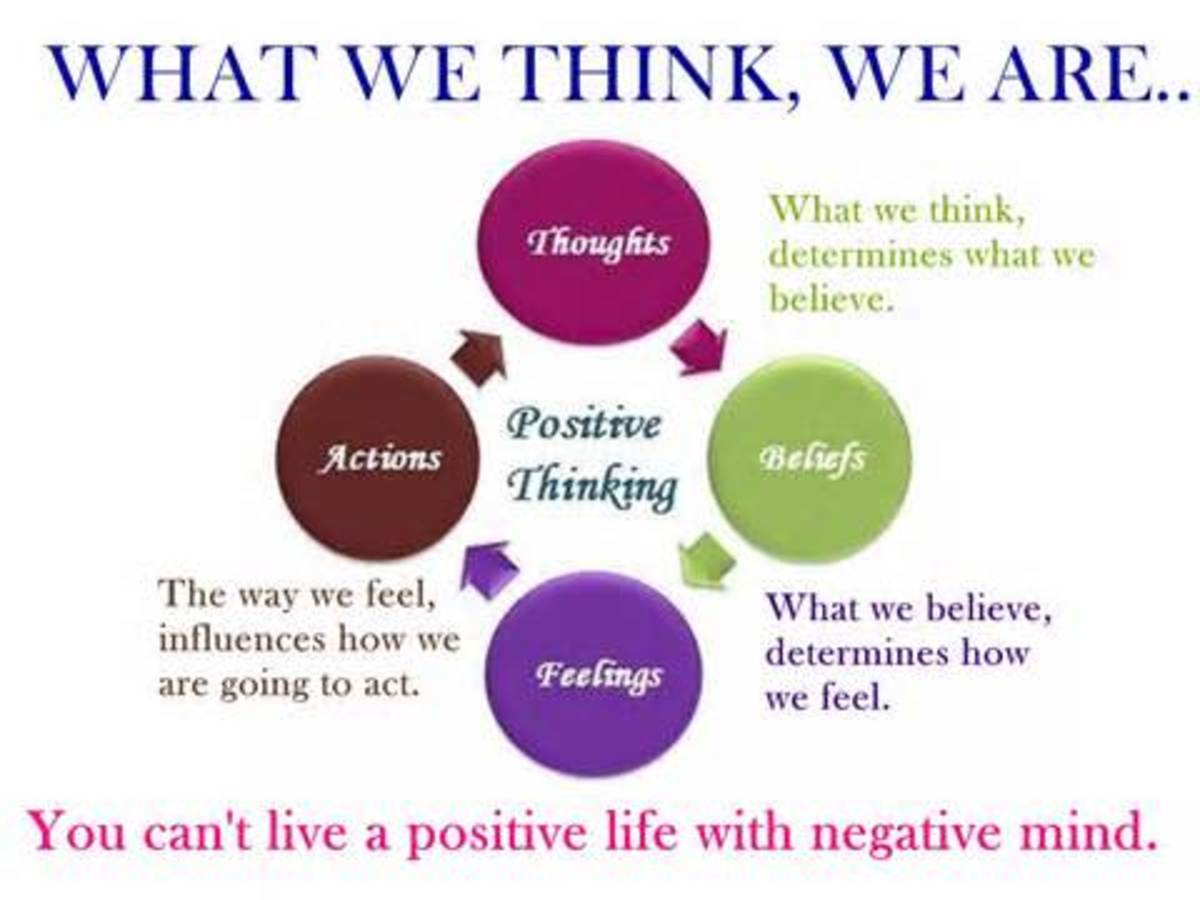- HubPages»
- Health»
- Personal Health Information & Self-Help»
- Mentally & Emotionally Balanced Living
Positive Thinking: A Practical Guide

I think we all know by now that positive thinking is a beneficial thing. But what does it really mean to "positively think"? We've all heard sayings like, "try to see the glass half full" or "look on the bright side". But when we get bad news, or a big bill, or we see a number on the scale that we despise, or we find ourselves in a rotten mood that we just can't get out of, sometimes it's not so easy to apply those perky little pieces of advice to our real lives. So, how do we secure that silver lining up in the sky and link it with our real thoughts here on the ground? The following practical tools of positive thinking hold the key. With some awareness of what you are saying to yourself, and techniques to transform your thoughts, you will be well on your positive way.
The Practical Tools of Positive Thinking
The first step in learning how to think positively is awareness. We have so many thoughts every day, every minute, that most of the time we're not even aware of what we are saying to ourselves. That's why you need to teach yourself how to tune into your thoughts and really hear the conversation within your own mind. This step alone can be transforming. If you are new at this, you may need to jot your thoughts down, repeat them aloud to yourself, or tell them to someone else in order to become aware of what you are thinking. For example, as you are reading this, you are having thoughts. What are they? Try and recall them. The thoughts are there, you just need to listen for them. When you are in a social situation, even in conversation, what thoughts are going through your mind? Are you thinking, "I love her hair. I want to look like that. I need to lose weight. Why did I just say that? or Why am I so dumb?" If you've never been aware of your thoughts, you may be surprised by what you are saying to yourself. But as you become aware, you can then become alert to your thoughts simply by "tuning in" to them.
It is so important to track your inner dialogue because your thoughts control your feelings and your actions. You may wonder sometimes why you're in a bad mood, or why you overeat or overspend or overanything, but the answer is always in your thoughts. Your thoughts are driving your every move. Here are a few examples from my own life. This morning I stepped on the scale and I DID NOT like the number at all. OK, I admit, I HATED it. My first thoughts were, "UGH! How can this be? Why have I been eating so much? How did I let myself gain this much weight?" Obviously, all of these thoughts were negative ones, and they led me to think more negative thoughts, such as, "I feel like just giving up. I might as well have ice cream for breakfast. Screw today. I'll start tomorrow." You can see how these thoughts would not only put me in a bad mood, but would also lead me to some bad actions, too! My thoughts were taking me straight toward a big old binge and a bad day. Not very positive at all.
Here is another example. I got the mail yesterday and in it was my son's very first college tuition bill. I opened it up, saw a hefty balance due, and a due date that was only two weeks away. My first thoughts were, "OMG! We only have two weeks? That is so much money! How on Earth are we going to pay all of this in just two weeks? I wish we had more moneyl Why don't we have more money?" I know, this doesn't sound very positve for a writer who believes in positive thinking. In both cases, with the scale and the bill, my negative thoughts led me to negative results in the form of anxiety. But the key in both of these examples is that I caught myself silently saying these things. I was aware. And once I was aware, I could change my thoughts. You see, your thoughts are like butterflies. Fleeting and hard to catch. But once you grasp them, it is beautiful what you can see. Butterflies also represent positive change. And once you change your thoughts, the transformation in your attitude and your actions will be amazing.
Changing your thoughts
This is the nitty-gritty part of positive thinking and where the real work comes in. Once you are aware of your negative thoughts,you change them to positive ones. But how? The key here is that the new thought has to make you feel better. It can't be a thought that is too broad or too unbelievable (unless that thought works for you) but should instead be something you say to yourself that makes you feel empowered and gives you hope. For example, when I stepped on the scale, a thought like, "at least you don't weigh 300 pounds", although positive, would not have made me feel any better. Even a positive affirmation where I visualized the outcome that I wanted by saying to myself, "I am thin and at my goal weight!" would not have changed my outlook, because I simply wouldn't have believed it. (Visualizations are a positive technique, though, and I'll mention them later.) What did work for me at that moment was asking myself this question: "What can I do to make this better, instead of worse?" That thought/question, although not your stereotypical "positive thinking" mantra, is what actually made me feel more positive! I could answer it with such thoughts as, "I can take a walk. I can eat a healthy breakfast. I can drink more water." These thoughts, although not all "sunshine and rainbows" as positive thinking is sometimes thought of, led me to a better outlook and in turn to better actions. (Like taking a walk!) I became positive and hopeful about the weight coming off instead of being mired down by all the negatives I had been focusing on. This is positive thinking! I had the same results with my son's college bill. I knew I needed to change my thoughts, but I also knew that I needed to find the thoughts that would make me feel better, more hopeful and more productive. My changed thought became: "Take it one step at a time, just look at the numbers, and see what needs to be done." These thoughts were so much more comforting to me than the anxiety-producing ones I had been thinking. These positive thoughts led me to more positive actions. I wrote the tution number down, subtracted from that the amount of my son's scholarship, the amount of the grants available to him, and the amount in his savings. That still left us a balance due, but one that, although it won't be a breeze, is something we can make happen. I also made a mental note to call the scholarship committee to find out how to get that money to my son's school on time. I felt more in control of the situation, less anxious, and actually excited for my son. I felt positive about it because I thought positive about it.
For some people, this technique takes a lot of work, but for others, positive or transformed thoughts come naturally. My husband is a natural at it. I look at a mess, and my thoughts are "look at all this work! I don't even know where to start. Why do I have to do this? What a pain!" My husband looks at a project, any project, and thinks only of the positive end result. He thinks, "Where should I start?" and takes it one step at a time. These are the thoughts he has:"this is going to be great when it's done. I feel good about this work and I am grateful I can do it." My husband has been a positive thinking role model for me as he always thinks about what he has, and not about what he doesn't. He constantly transforms his thoughts to get into a positive mindset, no matter what the situation, and is always in a good mood as a result. I also learned a lot about these techniques from life coaches Brooke Castillo and
Meadow Devor. I'm sure there are "positive thinking" people in your life as well. Seek them out and ask them about their attitude, mood and thoughts. Learn from what works for them, and try to emulate the way they positively think. Experiment with different thoughts, but always find what works best for you.
Finding the right positive thoughts for you
There are a lot of ways to approach positive thinking. You can use positive affirmations such as "I am a beautiful, worthy person, deserving of great things." You can visualize what you want out of life, by seeing yourself, for example, in a mansion, a beautiful car, with a million dollars, or with a perfect body. You can also use many different forms of meditation, including guided, spiritual and transcendental. You can tap into an attitude of gratitude by focusing on and/or writing down the blessings in your life. Each of these methods can be very beneficial for positive thinking and for achieving a positive outlook.For me, though, I find the "transformed thought" technique which I described above to be the most practical and pragmatic. By asking yourself an empowering question or coming up with a more comforting, energizing, positive thought, you can can turn your mood around and begin working toward the goals you want to achieve. I've also found that this type of positive thinking seems to attract more and more positive things toward me. This transformed thinking can take some practice until you get the thought that works for you. But when you get it, you will know. One thought that works for me when I want to overeat, for example, is simply to say to myself, "I can have it tomorrow." That takes away any anxiety for me and lets me know that although I can't have that tempting treat today, I can have it tomorrow. You too can experiment with the thoughts that do the trick for you.
When you find yourself in need of some uplifiting thoughts, try turning to any of these positive thinking techniques to see which one works for you. Do you need a positive affirmation? Will some imagery or visualization change your mood? A few entries in your gratitude journal? How about a few minutes of mediation? All of these techniques can help get you in a positive frame of mind, but the goal is always to be aware of the thoughts you are thinking, and to transform them into ones that make you feel your best. Remember, the key is to find what thoughts work for you. Once you tap into the right thought, you will feel more positive, and your actions will follow. That is the power of positive thinking and that is the point at which true transformation can begin.









